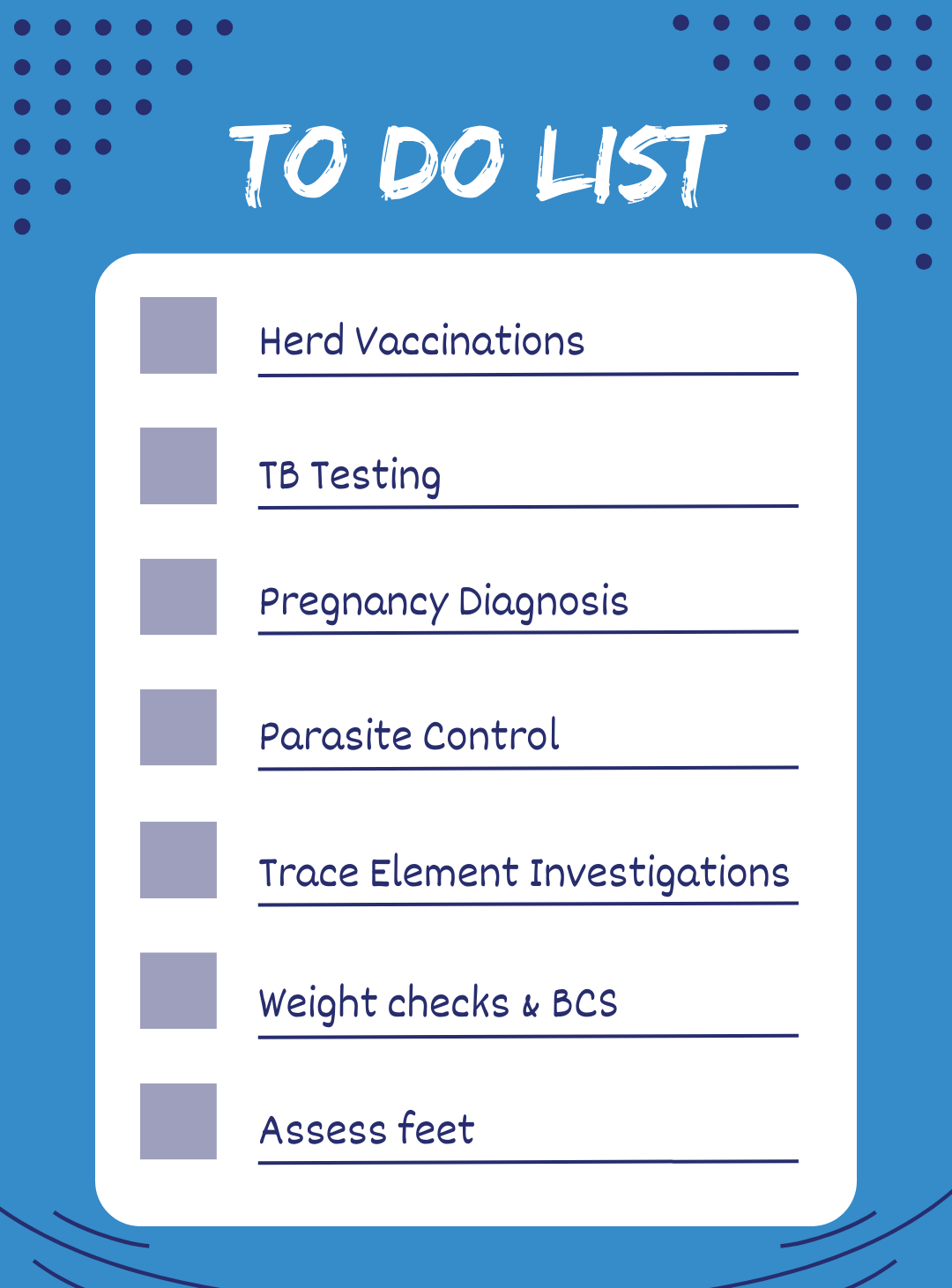With cattle due to come in for the winter, let’s think ahead about the husbandry tasks that will need completing. Housing is an excellent time to carry out many tasks that aren’t so simple during the grazing period. Here are some of the things you may include on your own to-do list.
- Herd Vaccinations
- TB Testing
- Pregnancy Diagnosis
- Parasite Control
- Trace Element Investigations
- Weight Checks & BCS
- Assess Feet
With a list this long, the key is to be prepared! Keep reading for more detail on our suggestions.
Herd Vaccinations
Vaccinations are herd specific; we encourage having a conversation with one of our vets if you are considering vaccinating your cattle for the first time. Vaccinations will depend on pathogens present on your farm and your farming protocols. Some vaccinations to consider include, BVD, IBR, and Leptospirosis. However, for those who already have a vaccination plan in place, don’t forget to keep up with these! Most vaccines require boosters and what better time to carry these out than at housing when all of your cattle are housed and easily accessible. You can even be efficient and tie this in with other housing tasks such as TB testing and pregnancy diagnosis.
TB Testing
Autumn/ winter is the busiest time of year for us with TB testing and - for obvious reasons -the most preferential time of year for you! We highly advise being organised, booking in any tests with as much notice as possible so we are better able to fulfil your needs and requests.
Pregnancy Diagnosis
Pregnancy diagnosis is an essential part of fertility management and housing is an excellent time for scanning spring calving herds. Using manual and ultrasound palpation, our vets are able to detect pregnancy from as early as 30 days gestation. It is the early identification of non-pregnant cattle that is most important and the recognition and treatment of fertility problems that provides economic benefit of pregnancy testing.
Parasite Control
Perhaps one of the most complex and widely talked about tasks for housing is parasite treatments. COWS (Control Of Worms Sustainably) has some really great guidance on their webpage on the steps you should be taking this autumn to protect your herd from parasites. The most important points to consider are: diagnosis and control of gut worms and liver fluke and protection against mites and lice. We have a really handy flow chart in our resources section to determine a plan of action for the parasite control of your herd.
Trace Element Investigations
Trace elements are minerals such as copper, selenium, cobalt and iodine and are essential for life. Optimal herd performance depends on trace elements being supplied correctly; improving growth rates and fertility. By blood testing cattle at housing, we are able to assess their trace element intake from the grazing period and decide if further supplementation is required for the spring turnout.
Weight Checks and BCS
We are likely to be seeing cattle coming in from the grazing period quite a lot fatter – especially compared to last year’s poor grazing conditions! Although this is great for the store beasts, it isn’t such good news for the sucklers. Ideal body condition score at calving is 2.5-3.0. Fat cows due to calve this autumn/winter are at greater risk of prolapses and difficult calving’s due to depositions of fat narrowing the birth canal. Conversely, thin cows can also cause problems at calving too - they typically produce less colostrum and raise weak calves. Following calving, cows that are too fat or too thin are more susceptible to post calving complications as well as having poor fertility with failure to cycle and conceive. We highly recommend body condition scoring suckler cows at housing to ensure they are grouped and fed accordingly and achieve target BCS ideally 6 weeks before calving.
Assess Feet
Lameness in beef cattle is frequently overlooked but can be one of the main causes of antibiotic use in a herd. Lameness is unavoidable, but there are factors to help reduce the incidence. Firstly, spend time assessing the feet and trimming anything with long toes or mobility issues. Early identification and treatment are essential to avoid irreversible damage and spread of infection. Consider routine foot trimming with a trained professional. Bare in mind trimming should be avoided in the four weeks prior to and four weeks after calving. Secondly, ensure environmental factors favour good foot health: reduce infection pressures – winter housing can lead to a flare up of pathogens due to poor slurry management; ensure good and gentle handling facilities, e.g., reduce sharp corners.
Ultimately, all of these considerations along with good housing and infrastructure will prove to have positive impacts on animal health and productivity. If you would like to discuss anything further, please call us at the practice and your query can be directed to the right person. Should you like to read more about how to improve your housing, download the below PDF to read an issue of AHDB’s Better Returns on beef housing. They go into detail about ventilation, hygiene and a checklist on how good your buildings are.


